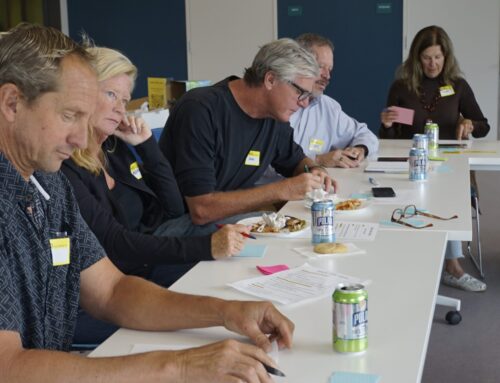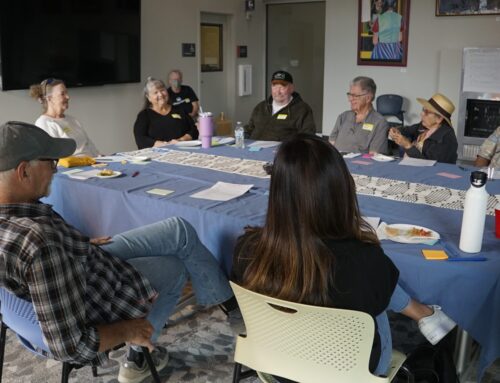Read Santa Cruz Local's Election Guide
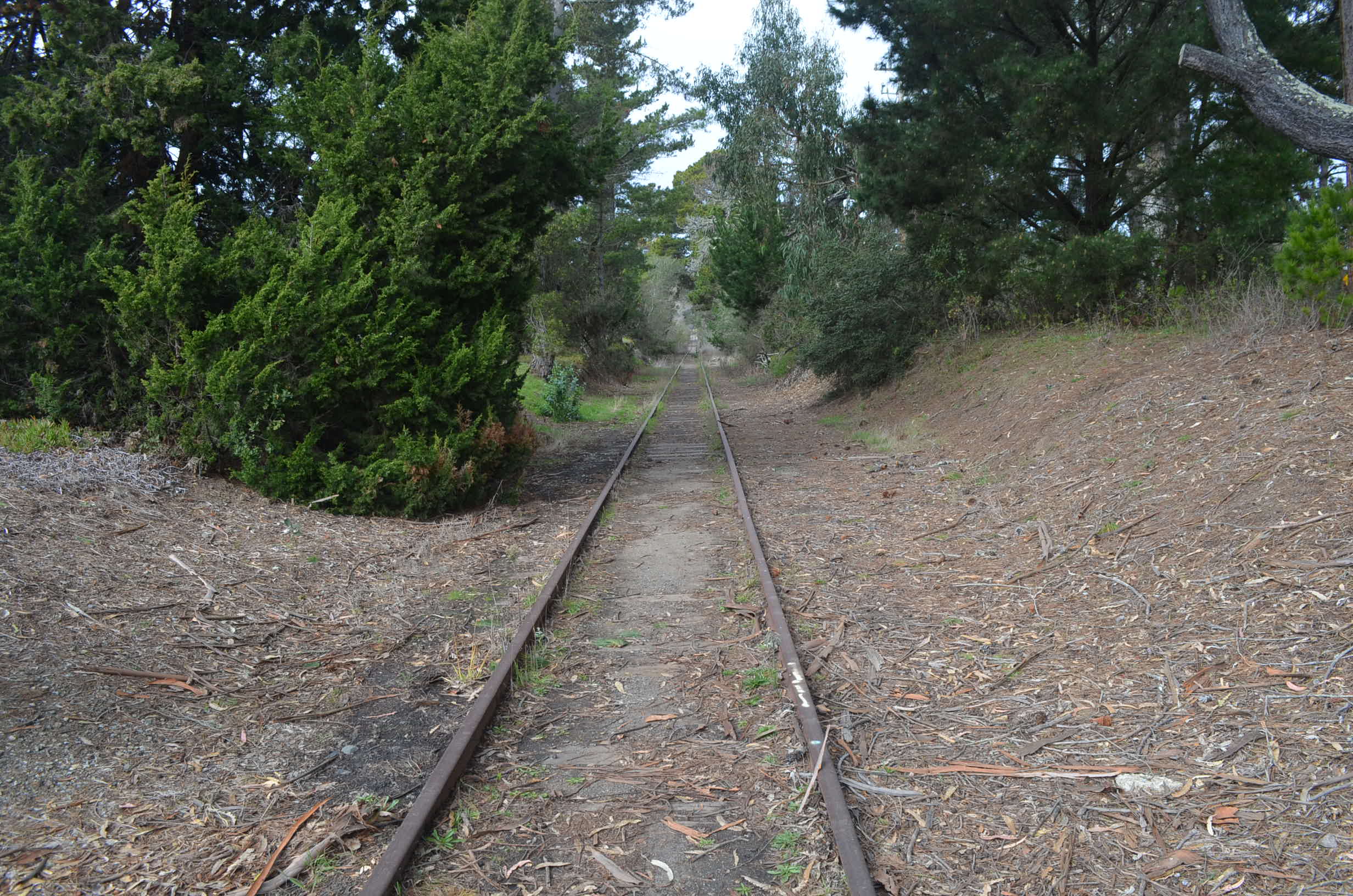
Readers have asked many questions about Measure D and the Santa Cruz Branch Rail Line. In part of Aptos, the line runs near Mar Vista Drive. (Stephen Baxter — Santa Cruz Local file)
SANTA CRUZ >> On June 7, Santa Cruz County residents will vote on Measure D, the Greenway ballot initiative.
The ballot measure, spurred by local nonprofit Santa Cruz County Greenway Inc. and more than 12,000 valid signatures, would change the Santa Cruz County’s General Plan to promote Greenway’s vision for a trail: two lanes of bike traffic, a divider and a walkway. Current plans call for a shared walk and bike path on the rail line or next to the rail line.
In recent weeks, Santa Cruz Local readers asked several questions about Measure D. Readers said they wanted to understand what’s at stake legally and symbolically for the rail trail and for potential passenger rail service on the Santa Cruz Branch Rail Line. Readers also wanted to further understand railbanking and the role it plays in trail construction and rail transit.
To find the answers, Santa Cruz Local spoke to:
- Guy Preston, executive director of the Santa Cruz County Regional Transportation Commission. Preston runs the agency that owns the rail line, but he does not vote on the commission. Preston relayed information from Steven Mattas, attorney for the Santa Cruz County Regional Transportation Commission.
- Jason Hoppin, spokesman for the County of Santa Cruz. Hoppin relayed information from County Counsel Jason Heath.
- Bud Colligan, steering committee member of Greenway. Greenway gathered signatures to put Measure D on the ballot.
- Mark Mesiti-Miller, co-chair of No Way Greenway campaign committee. This group leads a campaign against Measure D.
Other information was gathered from:
- Full text of Measure D.
- County Counsel Jason Heath’s impartial analysis of Measure D.
- County of Santa Cruz staff report on Measure D.
- County of Santa Cruz workshops on designs for the rail trail on Segments 8, 9, 10 and 11 in April.
Short background
The Santa Cruz County Regional Transportation Commission owns the 32-mile Santa Cruz Branch Rail Line from Watsonville to Davenport. Commission staff, as well as planners from the County of Santa Cruz, City of Santa Cruz and design consultants are now accepting public feedback on designs for two versions of a rail trail from Santa Cruz to Aptos in several segments:
- An “ultimate” plan would build a paved bike and walk path parallel to the railroad tracks and leave the tracks intact for future passenger rail service.
- An optional “interim” plan would remove the tracks and build a paved bike and walk path on top of where the rails now stand. The plan is to eventually remove the path and build the “ultimate” path parallel to the tracks to make way for passenger rail. Building the trail twice with the interim plan is more expensive, everyone involved said. Many rail supporters believe the “interim” plan will make it difficult or impossible to create a passenger rail system because of costs, legal reasons, political will and other factors.
The 12 members of the Santa Cruz Regional Transportation Commission are expected to vote on whether they want the “interim” plan with a path on the tracks or the “ultimate” plan of a path next to the tracks. A draft environmental impact report on the two plans is due at the end of the year and a final report is due in spring 2023.
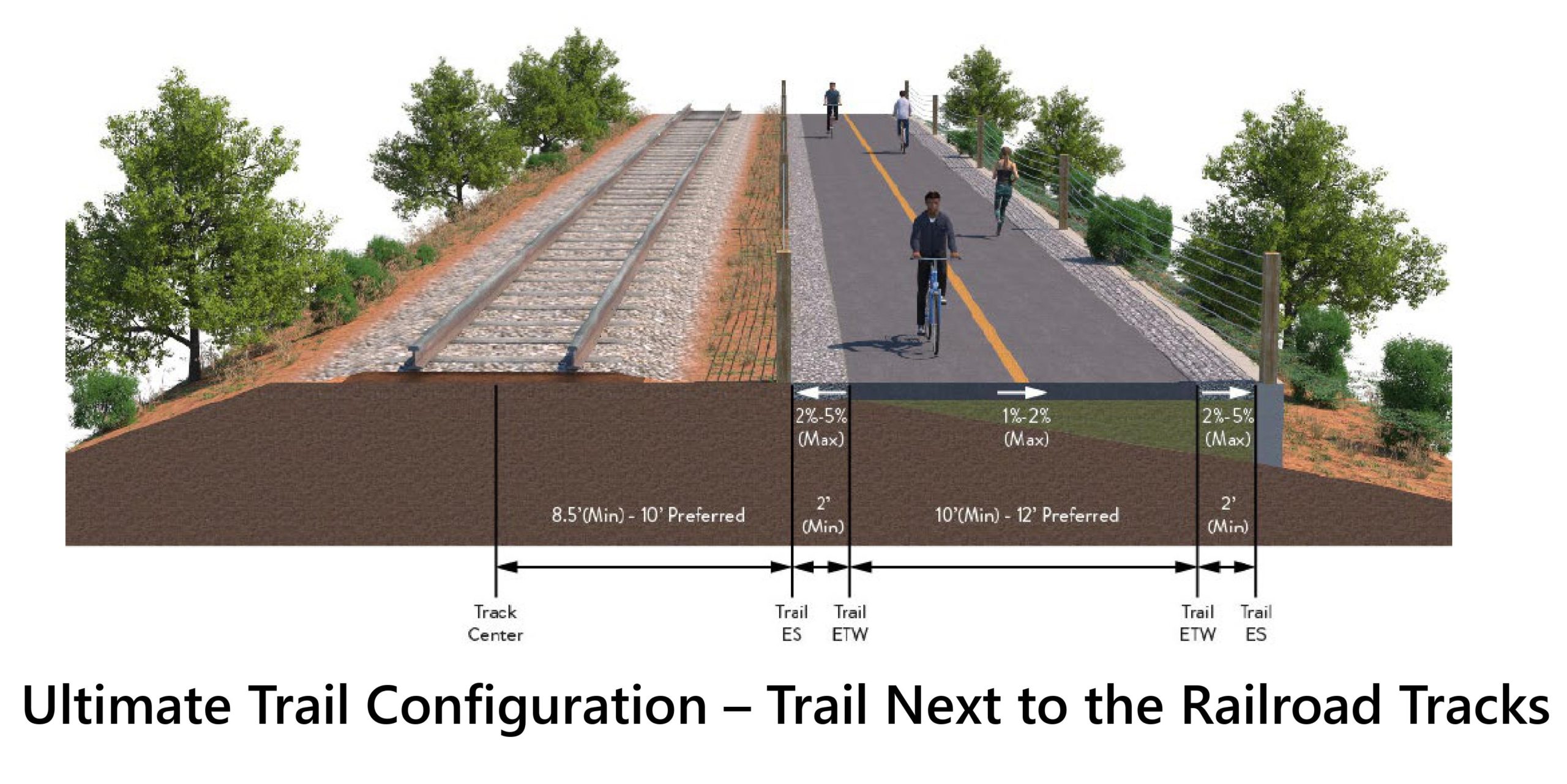
Planners have described an “ultimate” plan with a path next to the railroad tracks. On Segment 9 from the San Lorenzo River to 17th Avenue in Live Oak, the ultimate path is planned about 10 to 12 feet wide because of constraints with trees, hills, legal right-of-way and other factors, engineers said. On Segment 10 from 17th Avenue to 47th Avenue, it is “generally 12 feet wide but reduced in some areas to navigate some constraints,” said Rob Tidmore, Santa Cruz County Public Works project manager, during an April 6 public workshop. (Santa Cruz County Regional Transportation Commission)
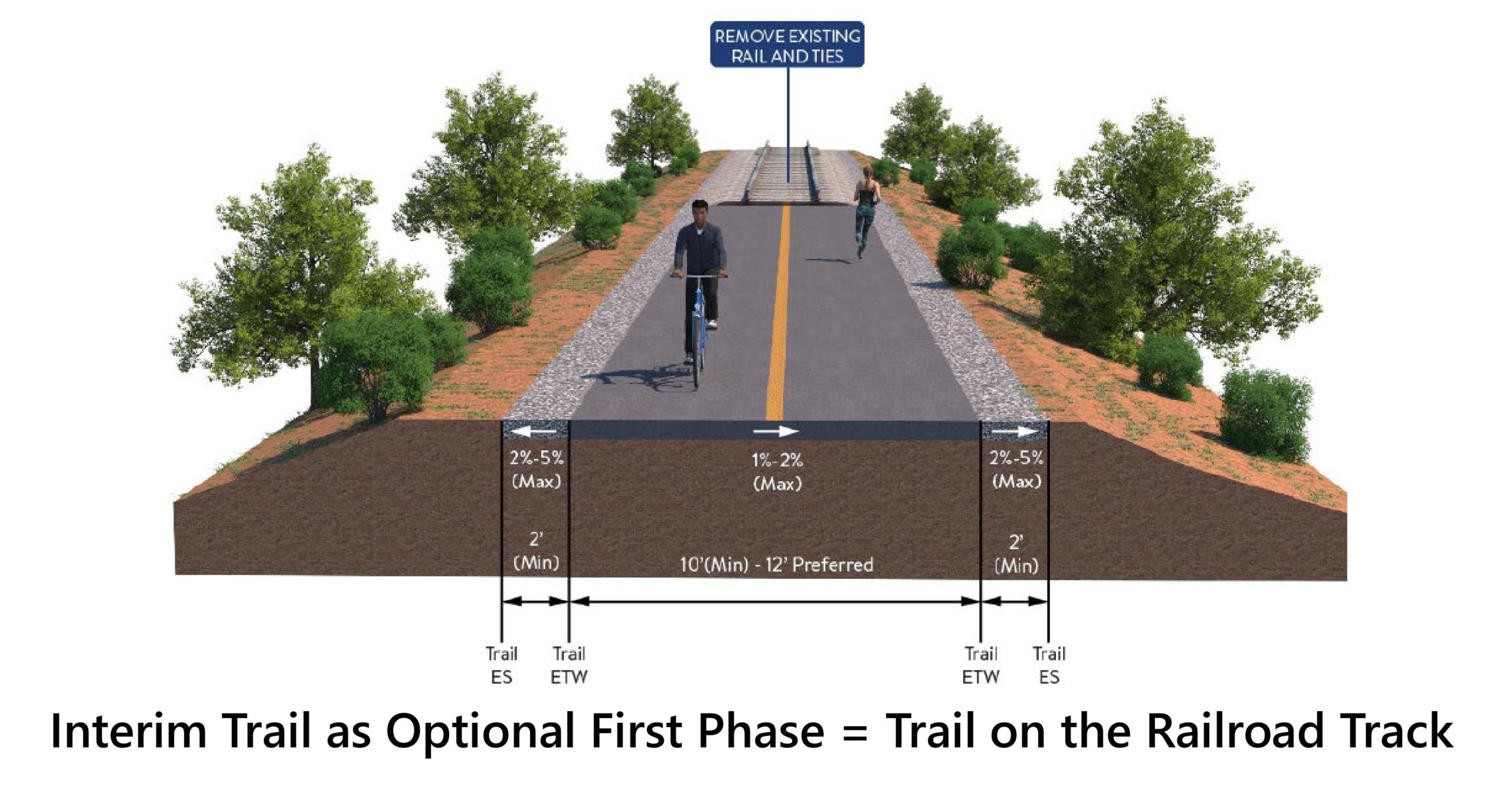
Planners have described an “interim” plan with a path on the rail line. On Segment 9 from the San Lorenzo River to 17th Avenue in Live Oak, it is planned to be 12 to 16 feet wide, engineers said. On Segment 10 from 17th Avenue to 47th Avenue, it is “generally 16 feet wide,” said Tidmore. “But just like the other alternative it is reduced in some areas to 12 feet to navigate constraints.” (Santa Cruz County Regional Transportation Commission)
Reader questions
Here are answers to some questions from Santa Cruz Local readers.
What is the purpose of Measure D?
Measure D proposes changes to the County of Santa Cruz’s General Plan. The planning language would shift toward a paved bike and walk path on the Santa Cruz Branch Rail Line. It takes out language in the General Plan related to “passenger rail service.” Measure D needs more than 50% of the vote to pass.
- Because the County of Santa Cruz and the Regional Transportation Commission are separate agencies — and the Regional Transportation Commission owns the rail line — Measure D does not legally decide whether there will be passenger rail on the rail line. That is the legal opinion of leaders and attorneys from the Santa Cruz County Regional Transportation Commission, the County of Santa Cruz and Greenway representatives who initiated Measure D.
- No Way Greenway representatives believe Measure D’s legal effects are further reaching, and we’ll get into that below.
- Measure D’s passage would not stop planning for the rail trail or passenger rail, according to the legal opinion of the County Counsel Jason Heath and Regional Transportation Commission attorney Steven Mattas. Decisions on planning for the rail trail and passenger rail will be made by a majority vote of members of the Regional Transportation Commission, Heath and Mattas said.
If the Regional Transportation Commission ultimately will decide on whether passenger rail service will be pursued, why should I vote on Measure D?
Measure D will weigh county voters’ preference on whether they want to continue to pursue passenger rail. That’s according to the Regional Transportation Commission executive director, Greenway leaders, and a spokesman and county counsel for the County of Santa Cruz. It also could be interpreted as a poll on whether voters want the “interim” path on the rail line or the “ultimate” path next to it. But again, all of those decisions ultimately will be made by the Regional Transportation Commission rather than voters.
“The changes to the General Plan are more symbolic — that this is what the county overall is saying its direction is with transportation,” said Bud Colligan, the Greenway steering committee member. He essentially said the vote is not meant to be legally binding, but rather to help sway members of the regional transportation commission to vote for the “interim” path on the rail line that is closest to Greenway’s vision.
Santa Cruz County Counsel Jason Heath and Jason Hoppin, a spokesman for the County of Santa Cruz, agreed. “We think this vote is largely advisory and not prescriptive,” Hoppin said, after speaking with Heath on April 6. “The significance of the vote is what the people say: How many people are on one side or the other,” Hoppin said.
Mark Mesiti-Miller, the co-chair of the No Way Greenway campaign committee, said he believed that the changes to the county’s General Plan were legally binding ways to prevent the county from planning for passenger rail.
Wait, Measure D removes the word “rail” and the phrase “passenger rail service” from the county’s General Plan. Does that kill the rail project?
Hoppin and Santa Cruz County Counsel Jason Heath said the removal of some rail language does not rule out passenger rail. “We do not believe that the absence of a word from a county planning document dictates or precludes any future uses of a piece of property — particularly one not owned by the county,” Hoppin said.
Leaders of the No Way Greenway campaign disagreed with the county’s interpretation.
“It is effectively a poison pill that will effectively prevent passenger rail transit from ever happening in Santa Cruz County,” Mesiti-Miller said. “I suspect that a lot of these kinds of issues will be litigated.”
Why does Measure D change the General Plan of the County of Santa Cruz rather than a policy of the Santa Cruz County Regional Transportation Commission?
“Changing the General Plan was the only way that we could get a countywide vote,” said Colligan, the Greenway steering committee member. A ballot initiative that addressed the Regional Transportation Commission would have required a statewide vote, Greenway supporters have said.
Why is Bud Colligan so personally interested in creating a paved path on the Santa Cruz Branch Rail Line?
Colligan was an early employee at Apple Inc. and CEO of Macromedia Inc. Macromedia is a software company that was sold to Adobe Systems Inc. in a $3.4 billion deal in 2005. Colligan helped start the Monterey Bay Economic Partnership, Santa Cruz Works, the Monterey Bay Housing Trust and the Watsonville and Salinas tech training organization Digital NEST. He said those projects have improved many people’s lives, but a path on the Santa Cruz Branch Rail Line would be used by 2 million to 3 million people annually. That impact would dwarf his other efforts, he said.
County of Santa Cruz planners recently presented designs for paths on the Santa Cruz Branch Rail Line in unincorporated county areas such as Live Oak and Aptos. If Measure D passes and the county’s General Plan excludes rail, can county planners continue work on rail trail plans if they involve potential passenger rail?
“Yes,” said Santa Cruz County spokesman Jason Hoppin. “We’re proceeding through our planning phases with both options in mind so that we can keep those options open and then implement whatever the [Regional Transportation Commission] wants to do.”
Guy Preston, executive director of the Regional Transportation Commission, added that even if those county planners stopped work because of a conflict of the county General Plan, “We could just take over that section of the rail.” Preston said the Regional Transportation Commission and the county are in a cooperative agreement to design the “interim” and “ultimate” rail trail designs. “We would just terminate that agreement,” Preston said. The Regional Transportation Commission could hire consultants to continue the design. “I don’t think it’s insurmountable,” Preston said.
Mark Mesiti-Miller, co-chair of the campaign committee for No Way Greenway, expressed surprise at Preston’s position that county planners could be replaced if needed. “If that’s true, that’s great news,” Mesiti-Miller said.
If the Greenway ballot measure passes, does that jeopardize Roaring Camp Railroads’ ability to run trains from Felton to the Santa Cruz Beach Boardwalk?
Roaring Camp owns and operates the Santa Cruz, Big Trees & Pacific Rail from Santa Cruz to Felton.
Preston, the Regional Transportation Commission executive director, said if the Greenway ballot measure passes it would “not directly” jeopardize Roaring Camp’s ability to run trains to the Boardwalk. If the Regional Transportation Commission chooses the “interim” path on the rail line, it would require railbanking the rail line. Railbanking is a process that allows the railroad to be converted to a trail. The purpose of railbanking is to allow a path on a rail line with the intent to return rail service, Preston has said.
No Way Greenway is opposed to railbanking in part because in the roughly 40 years the federal government has allowed it, very few trails have transitioned back to train use. A rail line in Denton County, Texas is one that transitioned back to a railroad.
The federal Surface Transportation Board will decide whether the line will be railbanked. If railbanking is approved, it would cut off Roaring Camp from getting trains or other equipment from South County and connections to other rail lines, said Preston and Roaring Camp Railroads CEO Melani Clark. Because of storm damage to bridges and other parts of the rail line in 2017, the line has not been safe for freight and Roaring Camp has not used the line to replace equipment since then, Preston said.
Roaring Camp Railroads CEO Melani Clark has said the Regional Transportation Commission should repair the freight line with grants, public-private partnerships and money from the 2016 transportation initiative Measure D. Measure D’s 0.5% sales tax approved by county voters in 2016 is expected to raise $500 million in 30 years for transportation projects.
Measure D from 2016 provides about $2 million for rail preservation each year, said Preston. That is far less than the estimated $50 million to $65 million needed for repairs. Because the line isn’t currently being used for freight, Preston has said it’s unlikely the commission would receive state or federal funds for repairs.
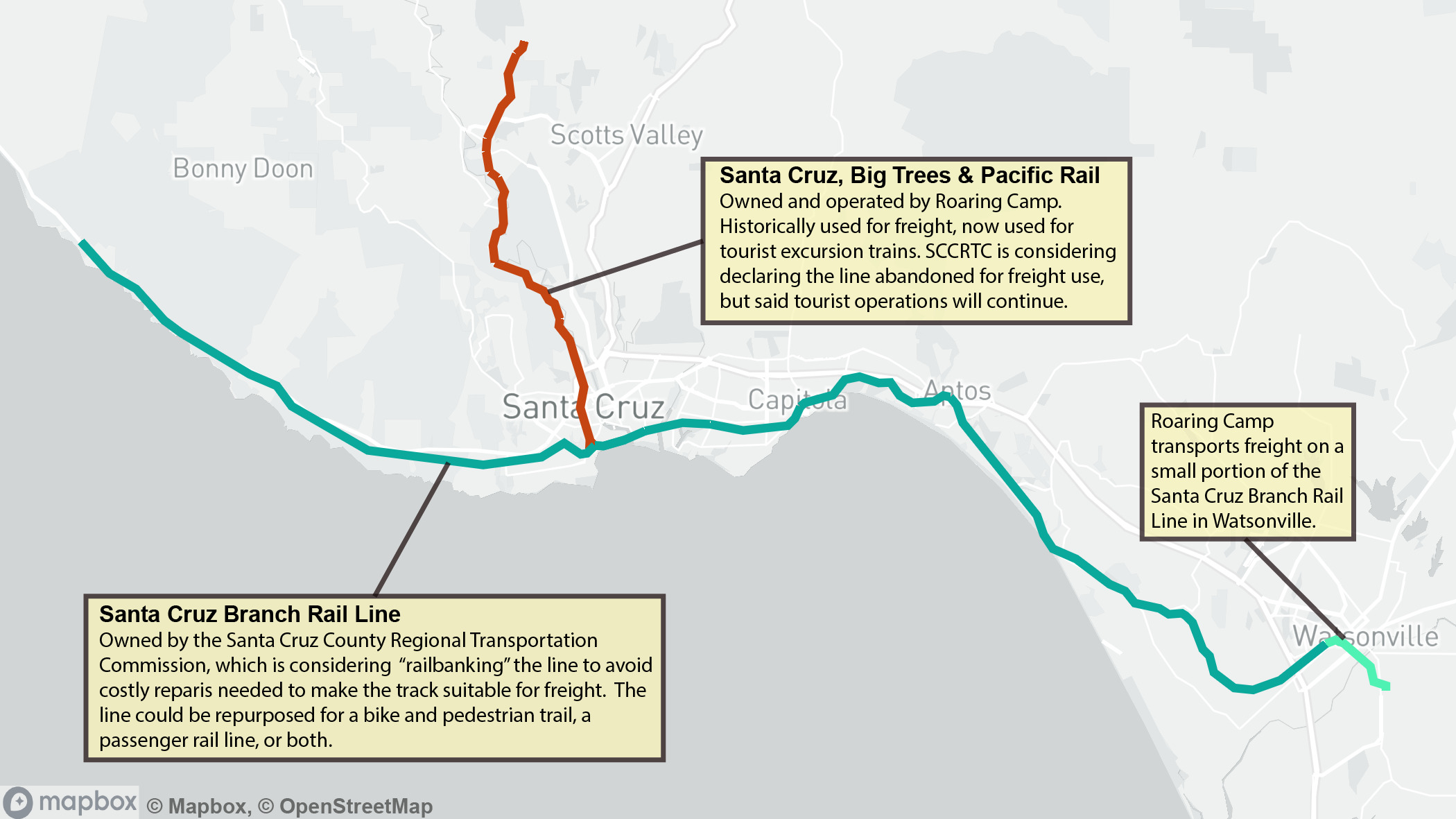
A map shows Santa Cruz County’s two rail lines: The Santa Cruz Branch Rail Line and Santa Cruz, Big Trees, and Pacific Rail, also known as the Felton Branch. (Caltrans)
In February, the Regional Transportation Commission discussed a potential abandonment of a federal designation for freight on Roaring Camp’s railroad. Roaring Camp leaders opposed the change due to concerns about a potential loss of access to Santa Cruz.
“I think the federal protections that [Roaring Camp] is talking about has to do with being a freight railroad,” Preston said. “Freight railroads have certain protections by the Interstate Commerce Act that preempts state law.” So railroad work does not have to comply with the California Environmental Quality Act, for instance. Preston said, “If freight was to be abandoned and we were to not continue with freight on our line, we would railbank it. There’s no question about it. That’s the safest way to preserve the corridor. And as a preserved corridor, I still believe that if you’re preserving it for future freight reactivation, it’s quite possible that you’re still exempt” from state law. “If Roaring Camp can continue to use it for what they’re currently using it for, for rail repairs, I still think that they would” have federal protections, Preston said. So in that respect, I don’t think it’s as big of a deal as they make it out to be,” Preston said.
“Right now, the agreement that they have with the Boardwalk is with our operator (St. Paul and Pacific Railroad, a division of Progressive Rail). They have a 10-year agreement with us from 2018. So it’s four years old, there’s six years left on it. And when that expires, that agreement that they have comes over to us,” Preston said. “I think you could lock up a more secure situation than that today.”
The Greenway initiative removes mentions of passenger rail from the County of Santa Cruz’s General Plan. If it passes, are local governments unable to apply for grants and funding needed to maintain the rail line, resulting in deterioration and ultimately failure?
Jason Hoppin, spokesman for the County of Santa Cruz, said the county does not plan to apply for grants to maintain the rail line regardless of whether Measure D is adopted. Measure D’s passage also would not preclude the Regional Transportation Commission from applying for money related to maintenance of the rail line because the transportation commission is a separate entity from the county.
However, Guy Preston, the Regional Transportation Commission executive director, has said that because the Santa Cruz Branch Rail Line is not used for freight and hasn’t since 2017, it’s unlikely the commission would receive state or federal funds for repairs.
The 2016 Santa Cruz County ballot Measure D provides about $2 million for rail preservation each year, Preston has said. That is far less than the estimated $50 million to $65 million needed for repairs. Because the line isn’t currently being used for freight, “We’re kind of stuck in this hole,” Preston has said.
Are the chances of railbanking low and what happens if the line cannot be railbanked? Could the trail still be built on the rail line or next to it? Could passenger rail service happen?
The federal Surface Transportation Board will decide whether the line can be railbanked. Either the whole line can be railbanked or none of it, said Preston, the executive director of the Regional Transportation Commission. If the line cannot be railbanked, then the “interim” path on the tracks cannot be built. Only the “ultimate” plan next to the tracks would be feasible.
As for the chances of railbanking approval, Preston had this to say: “When you really look at what the [Surface Transportation Board] considers with respect to railbanking and abandonment, really it’s abandonment first. If they’re willing to say that a line is in such poor condition and there’s not enough volume on it or need for it to financially justify the line anymore, that’s when they determine a line to be abandoned. And then railbanking at that point, it just becomes ministerial. They don’t get in the way of it one way or the other. So it’s really a determination of, is there enough freight on it versus the cost? Based on my calculations in terms of what it would take to bring this line back up, I can’t imagine that it would pencil out. It’s just a matter of how long the process is. But I think unless there is a major change in our use of this line for freight — if we went back to when it was built, with shipping and lumber. That’s how you justify the cost of doing that sort of maintenance. Not a few loads with potential clients. When there’s opposition and it’s argued it takes a long time.”
Preston also said there are also risks and potential problems with the “ultimate” plan alongside the tracks.
The “ultimate design” is a narrower path parallel to the tracks. There are buildings, parking lots and other private property that have encroached on areas alongside the tracks. It’s not certain that those encroachments can be dealt with to fit a path alongside the rail line. Preston said, “You have to consider it’s going to take time and do final design and to acquire right-of-way no matter what. And there’s risk associated with acquiring right-of-way, and right-of-way is needed with the design at least for Segment 12. What happens if you can’t acquire the right-of-way? If you can’t acquire the right-of-way — whether the right-of-way means acquiring parking in front of businesses or somebody’s home or somebody’s business — it isn’t any different than not being able to railbank. If you can’t acquire the right-of-way for your project, you can’t build your project.”
Read more:
- Rail trail plans detailed from Boardwalk to 17th Avenue – April 1, 2022
- Rail trail ballot measure outlined by Santa Cruz County staff – March 4, 2022
- Rail trail plans detailed from Santa Cruz to Aptos – Feb. 18, 2022
- Explainer: Roaring Camp and freight rail in Santa Cruz County – Feb. 1, 2022
Editor’s note: Additional information on proposed path widths have been added to image captions in this story. Bud Colligan is a $500 annual member of Santa Cruz Local. Stories that reference upper-level Santa Cruz Local donors prompt a disclosure. No donor, investor or advertiser of Santa Cruz Local has weighted influence or early access to any journalism we produce. Read our ethics statement.
Santa Cruz Local’s news is free. We believe that high-quality local news is crucial to democracy. We depend on locals like you to make a meaningful contribution so everyone can access our news. Learn about membership.
Stephen Baxter is a co-founder and editor of Santa Cruz Local. He covers Santa Cruz County government.




